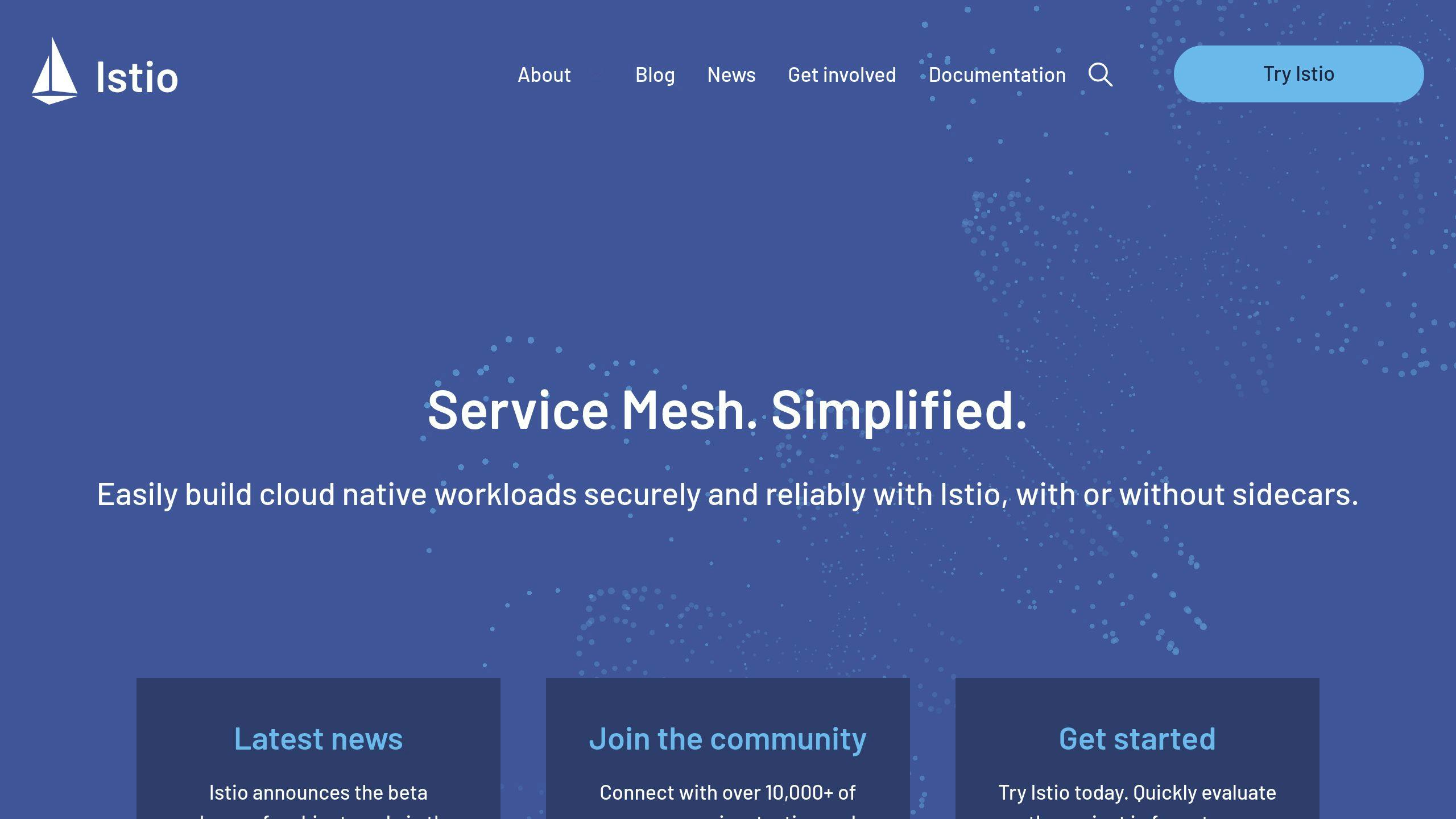Service Mesh Traffic Management Guide 2024

Want to master service mesh traffic management in 2024? Here's what you need to know in 60 seconds:
A service mesh handles traffic between microservices by:
- Routing requests between services
- Load balancing traffic
- Handling failures automatically
- Managing security and access
- Monitoring traffic flows
| Component | What It Does | Popular Tools |
|---|---|---|
| Data Plane | Routes traffic, encrypts data | Envoy, Linkerd proxies |
| Control Plane | Sets rules, manages security | Istio, Linkerd controllers |
| Sidecars | Personal proxy per service | Envoy |
Key Benefits:
- 25% less system downtime
- 30% faster problem fixes
- 40% better developer productivity
- 50% more peak traffic capacity
Which Service Mesh to Pick:
| Service Mesh | Best For | Main Strength |
|---|---|---|
| Linkerd | Small teams | Fast, simple setup |
| Istio | Large orgs | Advanced features |
| Consul | HashiCorp users | Tool integration |
The bottom line? Service mesh is now essential for microservices - it handles complex networking so your developers can focus on building features. This guide shows you exactly how to set it up and manage traffic in 2024.
Related video from YouTube
Basic Concepts of Service Mesh Traffic Management
A service mesh has two main parts that control network traffic. Let's break it down:
| Component | Role | What It Does |
|---|---|---|
| Data Plane | Traffic Handler | - Routes requests between services - Checks if services are healthy - Balances incoming traffic |
| Control Plane | Rule Manager | - Updates traffic routes - Sets and enforces rules - Handles system settings |
The data plane moves traffic, and the control plane tells it what to do. Here's how they work together:
| Plane | Main Jobs | Popular Tools |
|---|---|---|
| Data Plane | - Moves packets between services - Handles data encryption - Monitors service health |
Envoy, Linkerd proxies |
| Control Plane | - Creates traffic rules - Manages security certificates - Monitors system status |
Istio, Linkerd controllers |
Each service in your mesh gets a sidecar proxy. Think of it as a personal traffic cop that:
- Watches all traffic going in and out
- Makes sure security rules are followed
- Keeps track of what's happening
- Helps services find each other
Your service focuses on business logic while the proxy handles all the network stuff.
Here's what's in your traffic management toolbox:
| Tool | Purpose | Best Time to Use |
|---|---|---|
| Service Discovery | Maps out where services are | When services need to connect |
| Load Balancing | Shares traffic between services | During traffic spikes |
| Health Checks | Spots service problems | To prevent outages |
| Circuit Breaking | Stops problem spread | When services fail |
| Rate Limiting | Controls traffic volume | To keep services stable |
For example: Istio puts Envoy proxies to work in its data plane for these jobs, while Pilot (part of the control plane) manages how everything runs.
Advanced Traffic Management Methods
Let's look at how to control and manage traffic in your service mesh.
Request Routing and Load Distribution
Here's a breakdown of how different routing methods work in service mesh:
| Routing Type | Use Case | Implementation |
|---|---|---|
| Header-Based | A/B Testing | Routes based on request headers like 'end-user' |
| Weight-Based | Canary Testing | Splits traffic by percentage between versions |
| Path-Based | Feature Testing | Routes based on URL paths |
Traffic Split Methods
Want to test a new service version? Here's how to do it with canary deployments:
weightedBackendServices:
- backendService: review1
weight: 90
- backendService: review2
weight: 10
This means:
- 90% of users see the current version
- 10% see the new version
You can change these numbers as you test the new version's performance.
Circuit Breaker Setup
Circuit breakers stop your system from getting overwhelmed. Here's what to set:
| Parameter | Recommended Setting | Purpose |
|---|---|---|
| Max Requests per Connection | 100 | Limits requests to each backend |
| Max Connections | 1000 | Caps total concurrent connections |
| Max Pending Requests | 200 | Controls request queue size |
| Consecutive Errors | 3 | Triggers circuit break after failures |
Setting Time Limits
Don't let slow responses drag down your system. Use these timeout settings:
| Timeout Type | Setting | Description |
|---|---|---|
| Connection | 20s | Max time to establish connection |
| Request | 30s | Max time for request completion |
| Idle | 10s | Max time without data transfer |
Retry Settings
When things go wrong, here's how to handle retries:
| Setting | Value | Purpose |
|---|---|---|
| Base Interval | 25ms | Time between retry attempts |
| Max Retries | 3 | Number of retry attempts |
| Timeout | 2s | Total time for all retries |
Here's what happens when a service fails:
- System waits 25ms
- Tries again (up to 3 times)
- Stops after 2 seconds
This approach handles temporary hiccups without putting too much stress on your system.
sbb-itb-96038d7
How to Set Up Traffic Management
Let's break down traffic management in Kubernetes into simple, actionable steps.
Setting Up Service Discovery
Kubernetes uses three main parts to handle service discovery:
| Component | What It Does | How to Set It Up |
|---|---|---|
| Services | Links pods together | Add labels to match pods |
| Endpoints | Tracks pod locations | Kubernetes does this for you |
| Ingress | Handles outside traffic | Set up routing rules |
Here's a basic setup that works:
apiVersion: apps/v1
kind: Deployment
metadata:
name: nginx-deployment
spec:
selector:
matchLabels:
app: nginx
replicas: 2
template:
metadata:
labels:
app: nginx
spec:
containers:
- name: nginx
image: nginx
ports:
- containerPort: 80
Working with Different Protocols
Each protocol needs its own setup:
| Protocol | Port | Best For |
|---|---|---|
| HTTP/1.x | 80 | Basic web traffic |
| HTTP/2 | 443 | Modern web apps |
| gRPC | 50051 | Apps talking to each other |
| TCP | Custom | Older apps |
Managing Traffic Across Platforms
Here's what you need to control traffic between platforms:
| Setting | What It Does | Example |
|---|---|---|
| Load Balancing | Splits up traffic | Round-robin |
| Health Checks | Watches for issues | 5-second intervals |
| Failover | Handles problems | 3 tries |
Traffic Between Clusters
Copy this setup for routing between clusters:
apiVersion: networking.istio.io/v1alpha3
kind: Gateway
metadata:
name: cross-cluster-gateway
spec:
selector:
app: istio-ingressgateway
servers:
- port:
number: 443
name: tls
protocol: TLS
hosts:
- "*.global"
Edge Traffic Management
Control traffic at your network's edge:
| Part | Job | Main Settings |
|---|---|---|
| Ingress Gateway | Gets traffic in | Port, protocol, TLS |
| Egress Gateway | Sends traffic out | Allowed destinations |
| Rate Limits | Controls flow | Requests per second |
Set it up with:
kubectl apply -f samples/bookinfo/networking/bookinfo-gateway.yaml
Check if it works:
istioctl analyze
Connecting with Other Systems
Here's how different systems work together in a service mesh setup:
Cloud Service Setup
Want to use service mesh in the cloud? Here are your main options:
| Cloud Provider | Service Mesh Option | Key Features |
|---|---|---|
| AWS | App Mesh | EKS integration, DynamoDB versioning |
| Azure | Service Fabric Mesh | Built-in load balancing |
| GCP | Anthos Service Mesh | Multi-cluster support |
Here's a quick AWS App Mesh setup:
apiVersion: appmesh.k8s.aws/v1beta2
kind: Mesh
metadata:
name: my-mesh
spec:
namespaceSelector:
matchLabels:
mesh: my-mesh
Container Management
Here's what you need to control container traffic:
| Setting Type | Purpose | Example Config |
|---|---|---|
| Service Discovery | Find containers | DNS-based lookup |
| Health Checks | Monitor status | TCP/HTTP probes |
| Load Balancing | Split traffic | Round-robin |
Adding to CI/CD Pipelines
Want to add service mesh to GitLab CI/CD? Here's how:
stages:
- build
- deploy
- canary
deploy:
stage: deploy
script:
- kubectl apply -f service-mesh-config.yaml
- kubectl rollout status deployment/app
"API gateways typically handle ingress concerns, not intra-cluster concerns, and often deal with a certain amount of business logic."
Working with API Gateways
Let's break down traffic management:
| Component | Traffic Type | Use Case |
|---|---|---|
| API Gateway | North-South | External requests |
| Service Mesh | East-West | Internal services |
| Combined Setup | Both | Full coverage |
Using Integration Platforms
Need to connect third-party services? Here's what integration platforms offer:
| Platform Feature | Benefit | Implementation |
|---|---|---|
| Single API | Less code | One endpoint |
| Security Controls | Data protection | Built-in auth |
| Version Management | Update control | Auto-updates |
Endgrate connects 100+ pre-built integrations through one API, making service-to-service traffic management simple.
Summary
Service mesh changes how traffic flows in microservices. Here's what you need to know:
| Component | Function | Impact |
|---|---|---|
| Data Plane | Handles service-to-service traffic | 40-400% less latency with Linkerd vs Istio |
| Control Plane | Manages configs and policies | 30% faster incident fixes |
| Sidecar Proxies | Move traffic between services | 40% better dev speed |
Each service mesh has its sweet spot:
| Service Mesh | What It Does Best | Best For |
|---|---|---|
| Linkerd | Light on resources, quick setup | Teams that need speed |
| Istio | More tools, bigger community | Complex traffic needs |
| Consul Connect | Works with HashiCorp tools | HashiCorp users |
"Linkerd just worked out of the box — no extra configs needed. Istio would've needed lots of tweaks."
What works in practice:
- Pick service mesh at the start
- Match tools to your needs
- Set up monitoring from day one
- Use it when you hit 50+ services
- Lock down security with mTLS
| Feature | What It Does | Business Win |
|---|---|---|
| Circuit Breaking | Stops failure spread | 25% less downtime |
| Canary Deployments | Tests new code safely | 50% more peak load |
| Load Balancing | Spreads traffic smart | Better server use |
"Istio's complexity slows us down when we set up, fix, or check our clusters."
The numbers tell the story for 2024:
- Cut downtime by 25%
- Fix issues 30% faster
- Speed up devs by 40%
- Handle 50% more peak traffic
Service mesh lets you run microservices better - no extra code needed.
FAQs
What is the best practice of Istio routing?

Istio's default behavior sends traffic to all service versions. But you'll want a more controlled setup. Here's how to do it right:
| Step | Action | Why It Matters |
|---|---|---|
| Default Routes | Create VirtualService with default route per service | Stops traffic problems with new versions |
| Subset Management | Use "make-before-break" process | Prevents 503 errors during changes |
| Version Control | Update DestinationRules first, then VirtualService | Keeps traffic flowing smoothly |
When you change subsets, follow these steps:
To add a subset:
- Update DestinationRules
- Wait 5-10 seconds
- Change VirtualService
To remove a subset:
- Update VirtualService
- Wait 5-10 seconds
- Change DestinationRule
"Although the default Istio behavior conveniently sends traffic from any source to all versions of a destination service without any rules being set, creating a VirtualService with a default route for every service, right from the start, is generally considered a best practice in Istio."
Related posts
Ready to get started?

